How to recognize phishing scams like Sparkasse email scam?
Phishing/ScamAlso Known As: Sparkasse spam
Get free scan and check if your device is infected.
Remove it nowTo use full-featured product, you have to purchase a license for Combo Cleaner. Seven days free trial available. Combo Cleaner is owned and operated by RCS LT, the parent company of PCRisk.com.
What is Sparkasse email scam?
The purpose of this phishing email is to trick recipients into opening a fake website and providing their login credentials. It is disguised as a letter from Sparkasse's (German savings bank's) finance department. This email must be ignored.
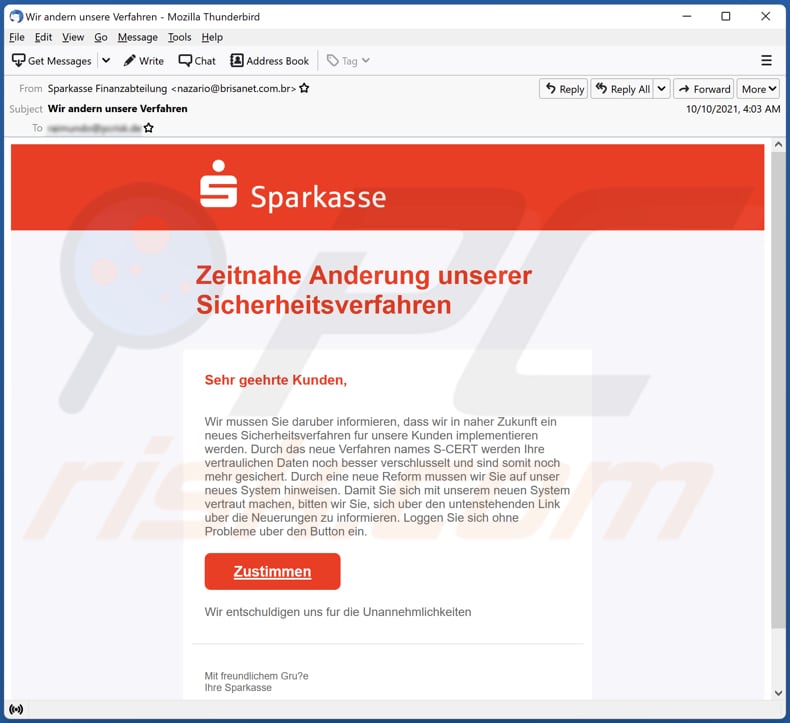
Sparkasse email scam in detail
This email claims that the savings bank will be implementing a new security procedure called S-CERT for their customers in the near future. It encourages recipients to click the "Zustimmen" hyperlink to read more about the reform. That link opens a fake Sparkasse website.
Scammers behind this phishing email seek to obtain login credentials used to access Sparkasse online banking accounts. It is possible that provided information could be used to steal accounts and make fraudulent transactions. Also, scammers may sell obtained information to third parties.
| Name | Sparkasse Email Scam |
| Threat Type | Phishing, Scam, Social Engineering, Fraud |
| Fake Claim | Sparkasse savings bank will implement new security measures |
| Related Domain | spk-datensicherung[.]com |
| Detection Names (spk-datensicherung[.]com) | Fortinet (Spam), Full List Of Detections (VirusTotal) |
| Disguise | Letter from the Sparkasse's finance department |
| Symptoms | Unauthorized online purchases, changed online account passwords, identity theft, illegal access of the computer. |
| Distribution methods | Deceptive emails, rogue online pop-up ads, search engine poisoning techniques, misspelled domains. |
| Damage | Loss of sensitive private information, monetary loss, identity theft. |
| Malware Removal (Windows) |
To eliminate possible malware infections, scan your computer with legitimate antivirus software. Our security researchers recommend using Combo Cleaner. Download Combo CleanerTo use full-featured product, you have to purchase a license for Combo Cleaner. 7 days free trial available. Combo Cleaner is owned and operated by RCS LT, the parent company of PCRisk.com. |
Phishing emails in general
As a rule, phishing emails are disguised as official, important letters from existing companies, institutions or other entities. The purpose of these emails is to trick recipients into providing sensitive information.
More examples of phishing emails are "Office 365 Email Scam", "New Mail Server System 4.0 Email Scam", and "ING Bank Email Scam". It is important to know that emails can be used to deliver malware (for example, ransomware).
How do spam campaigns infect computers?
Cybercriminals can use email letters to distribute malware by including malicious attachments or website links in them. Their goal is to trick recipients into downloading and opening a file designed to infect computers with malware.
It is important to mention that malicious documents opened with Microsoft Office 2010 and later do not infect computers unless users enable editing/content (macros commands). Although, documents opened with older MS Office versions do not ask for permission to enable macros commands so they could inject malware.
How to avoid installation of malware?
Do not trust irrelevant emails received from unknown addresses. More importantly, do not open links or files in those emails. It is very common for emails of this kind to be used for malware distribution. Furthermore, download files, programs from official pages and avoid using other sources.
Update and activate installed software with tools provided by its official developer. Have a reputable antivirus program installed on the operating system and run scans with it on a regular basis.
If you've already opened malicious attachments, we recommend running a scan with Combo Cleaner Antivirus for Windows to automatically eliminate infiltrated malware.
Text presented in the Sparkasse email scam (written in German):
Subject: Wir andern unsere Verfahren
Sparkasse
Zeitnahe Anderung unserer Sicherheitsverfahren
Sehr geehrte Kunden,Wir mussen Sie daruber informieren, dass wir in naher Zukunft ein neues Sicherheitsverfahren fur unsere Kunden implementieren werden. Durch das neue Verfahren names S-CERT werden Ihre vertraulichen Daten noch besser verschlusselt und sind somit noch mehr gesichert. Durch eine neue Reform mussen wir Sie auf unser neues System hinweisen. Damit Sie sich mit unserem neuen System vertraut machen, bitten wir Sie, sich uber den untenstehenden Link uber die Neuerungen zu informieren. Loggen Sie sich ohne Probleme uber den Button ein.
ZustimmenWir entschuldigen uns fur die Unannehmlichkeiten
Mit freundlichem Gru?e
Ihre Sparkasse2021- Sparkasse Finanzabteilung
Appearance of the fake Sparkasse website used to steal login credentials (GIF):
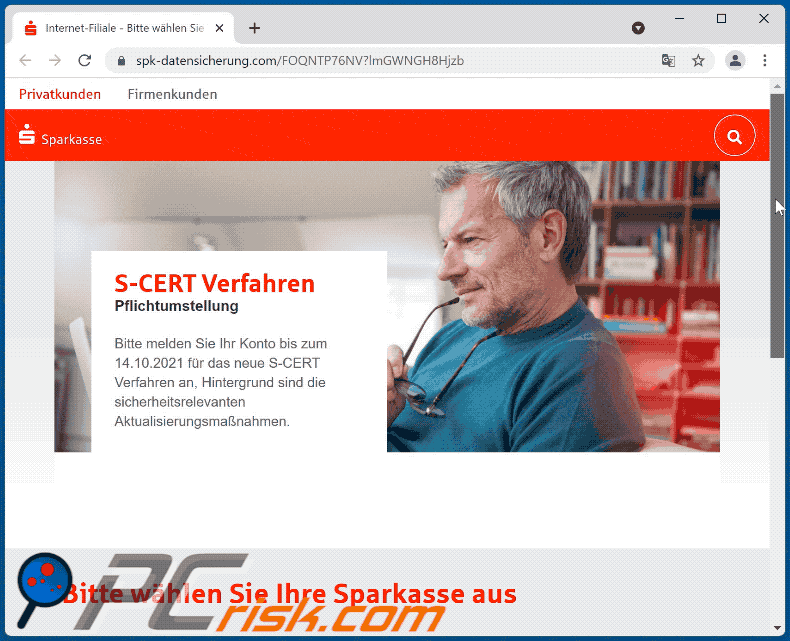
Another example of Sparkasse-themed spam email promoting an identical phishing site:
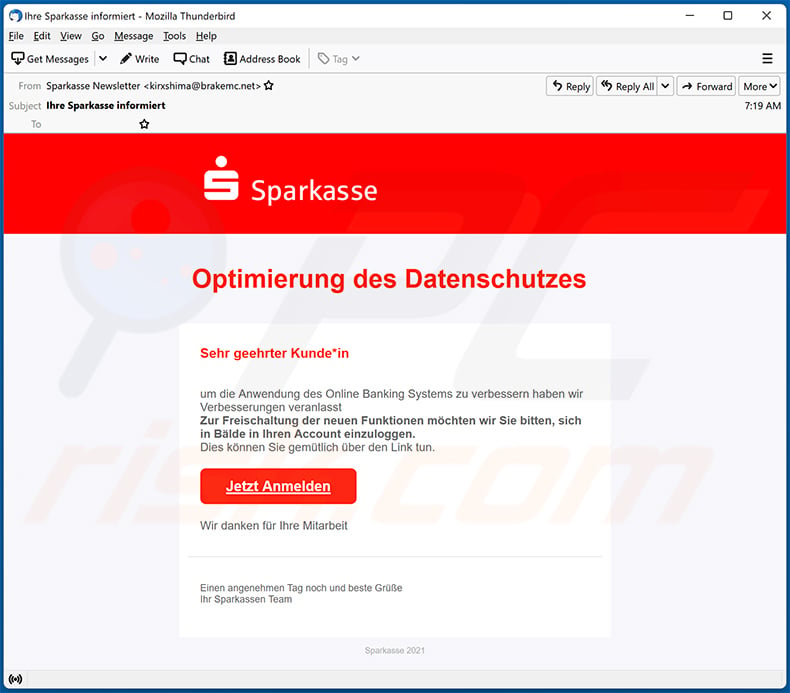
Text presented within:
Subject: Ihre Sparkasse informiert
Optimierung des Datenschutzes
Sehr geehrter Kunde*inum die Anwendung des Online Banking Systems zu verbessern haben wir Verbesserungen veranlasst
Zur Freischaltung der neuen Funktionen möchten wir Sie bitten, sich in Bälde in Ihren Account einzuloggen.
Dies können Sie gemütlich über den Link tun.
Jetzt AnmeldenWir danken für Ihre Mitarbeit
Einen angenehmen Tag noch und beste Grüße
Ihr Sparkassen TeamSparkasse 2021
Yet another example of Sparkasse-themed email scam:
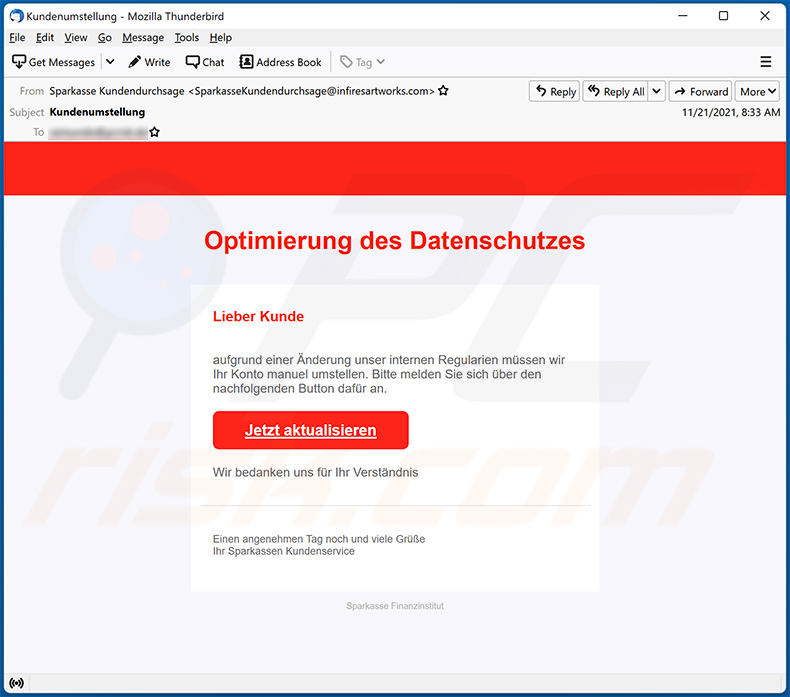
Text presented within:
Subject: Kundenumstellung
Optimierung des Datenschutzes
Lieber Kundeaufgrund einer Änderung unser internen Regularien müssen wir Ihr Konto manuel umstellen. Bitte melden Sie sich über den nachfolgenden Button dafür an.
Jetzt aktualisierenWir bedanken uns für Ihr Verständnis
Einen angenehmen Tag noch und viele Grüße
Ihr Sparkassen KundenserviceSparkasse Finanzinstitut
Additional example of Sparkasse-themed spam email:
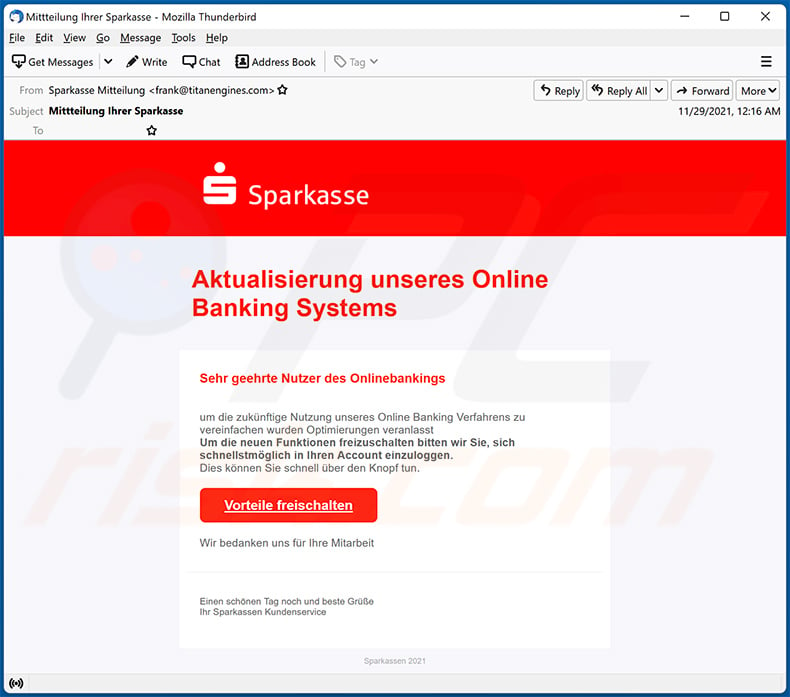
Text presented within:
Subject: Mittteilung Ihrer Sparkasse
Sparkasse
Aktualisierung unseres Online Banking Systems
Sehr geehrte Nutzer des Onlinebankingsum die zukünftige Nutzung unseres Online Banking Verfahrens zu vereinfachen wurden Optimierungen veranlasst
Um die neuen Funktionen freizuschalten bitten wir Sie, sich schnellstmöglich in Ihren Account einzuloggen.
Dies können Sie schnell über den Knopf tun.
Vorteile freischaltenWir bedanken uns für Ihre Mitarbeit
Einen schönen Tag noch und beste Grüße
Ihr Sparkassen KundenserviceSparkassen 2021
Instant automatic malware removal:
Manual threat removal might be a lengthy and complicated process that requires advanced IT skills. Combo Cleaner is a professional automatic malware removal tool that is recommended to get rid of malware. Download it by clicking the button below:
DOWNLOAD Combo CleanerBy downloading any software listed on this website you agree to our Privacy Policy and Terms of Use. To use full-featured product, you have to purchase a license for Combo Cleaner. 7 days free trial available. Combo Cleaner is owned and operated by RCS LT, the parent company of PCRisk.com.
Quick menu:
- What is Sparkasse spam?
- Types of malicious emails.
- How to spot a malicious email?
- What to do if you fell for an email scam?
Types of malicious emails:
![]() Phishing Emails
Phishing Emails
Most commonly, cybercriminals use deceptive emails to trick Internet users into giving away their sensitive private information, for example, login information for various online services, email accounts, or online banking information.
Such attacks are called phishing. In a phishing attack, cybercriminals usually send an email message with some popular service logo (for example, Microsoft, DHL, Amazon, Netflix), create urgency (wrong shipping address, expired password, etc.), and place a link which they hope their potential victims will click on.
After clicking the link presented in such email message, victims are redirected to a fake website that looks identical or extremely similar to the original one. Victims are then asked to enter their password, credit card details, or some other information that gets stolen by cybercriminals.
![]() Emails with Malicious Attachments
Emails with Malicious Attachments
Another popular attack vector is email spam with malicious attachments that infect users' computers with malware. Malicious attachments usually carry trojans that are capable of stealing passwords, banking information, and other sensitive information.
In such attacks, cybercriminals' main goal is to trick their potential victims into opening an infected email attachment. To achieve this goal, email messages usually talk about recently received invoices, faxes, or voice messages.
If a potential victim falls for the lure and opens the attachment, their computers get infected, and cybercriminals can collect a lot of sensitive information.
While it's a more complicated method to steal personal information (spam filters and antivirus programs usually detect such attempts), if successful, cybercriminals can get a much wider array of data and can collect information for a long period of time.
![]() Sextortion Emails
Sextortion Emails
This is a type of phishing. In this case, users receive an email claiming that a cybercriminal could access the webcam of the potential victim and has a video recording of one's masturbation.
To get rid of the video, victims are asked to pay a ransom (usually using Bitcoin or another cryptocurrency). Nevertheless, all of these claims are false - users who receive such emails should ignore and delete them.
How to spot a malicious email?
While cyber criminals try to make their lure emails look trustworthy, here are some things that you should look for when trying to spot a phishing email:
- Check the sender's ("from") email address: Hover your mouse over the "from" address and check if it's legitimate. For example, if you received an email from Microsoft, be sure to check if the email address is @microsoft.com and not something suspicious like @m1crosoft.com, @microsfot.com, @account-security-noreply.com, etc.
- Check for generic greetings: If the greeting in the email is "Dear user", "Dear @youremail.com", "Dear valued customer", this should raise suspiciousness. Most commonly, companies call you by your name. Lack of this information could signal a phishing attempt.
- Check the links in the email: Hover your mouse over the link presented in the email, if the link that appears seems suspicious, don't click it. For example, if you received an email from Microsoft and the link in the email shows that it will go to firebasestorage.googleapis.com/v0... you shouldn't trust it. It's best not to click any links in the emails but to visit the company website that sent you the email in the first place.
- Don't blindly trust email attachments: Most commonly, legitimate companies will ask you to log in to their website and to view any documents there; if you received an email with an attachment, it's a good idea to scan it with an antivirus application. Infected email attachments are a common attack vector used by cybercriminals.
To minimise the risk of opening phishing and malicious emails we recommend using Combo Cleaner Antivirus for Windows.
Example of a spam email:

What to do if you fell for an email scam?
- If you clicked on a link in a phishing email and entered your password - be sure to change your password as soon as possible. Usually, cybercriminals collect stolen credentials and then sell them to other groups that use them for malicious purposes. If you change your password in a timely manner, there's a chance that criminals won't have enough time to do any damage.
- If you entered your credit card information - contact your bank as soon as possible and explain the situation. There's a good chance that you will need to cancel your compromised credit card and get a new one.
- If you see any signs of identity theft - you should immediately contact the Federal Trade Commission. This institution will collect information about your situation and create a personal recovery plan.
- If you opened a malicious attachment - your computer is probably infected, you should scan it with a reputable antivirus application. For this purpose, we recommend using Combo Cleaner Antivirus for Windows.
- Help other Internet users - report phishing emails to Anti-Phishing Working Group, FBI’s Internet Crime Complaint Center, National Fraud Information Center and U.S. Department of Justice.
Frequently Asked Questions (FAQ)
Why did I receive this email?
Usually, scammers behind phishing emails do not target anyone in particular. They send the same letter to thousands of people hoping that someone will fall for their scam (for example, provide personal information, transfer money).
I have provided my personal information when tricked by this email, what should I do?
Victims who have provided login credentials should change all passwords as soon as possible. Victims who have provided other personal information like credit card details, ID card information should contact corresponding authorities.
I have downloaded and opened a file attached to an email received from cybercriminals, is my computer infected?
If the file attached to an email was executable, then a computer is probably infected. In other cases, malicious files cannot infect computers unless users perform certain actions. For example, malicious MS Office documents do not infect computers unless users enable macros commands in them.
I have read the email but didn't open the attachment, is my computer infected?
No, opening an email by itself is completely harmless. Recipients infect computers by clicking on website links or opening malicious attachments.
Will Combo Cleaner remove malware infections that were present in email attachment?
Yes, Combo Cleaner is capable of detecting and eliminating almost all known malware infections. It is common that high-end malware hides deep in the system. Therefore, it is recommended to run a full system scan.
Share:

Tomas Meskauskas
Expert security researcher, professional malware analyst
I am passionate about computer security and technology. I have an experience of over 10 years working in various companies related to computer technical issue solving and Internet security. I have been working as an author and editor for pcrisk.com since 2010. Follow me on Twitter and LinkedIn to stay informed about the latest online security threats.
PCrisk security portal is brought by a company RCS LT.
Joined forces of security researchers help educate computer users about the latest online security threats. More information about the company RCS LT.
Our malware removal guides are free. However, if you want to support us you can send us a donation.
DonatePCrisk security portal is brought by a company RCS LT.
Joined forces of security researchers help educate computer users about the latest online security threats. More information about the company RCS LT.
Our malware removal guides are free. However, if you want to support us you can send us a donation.
Donate
▼ Show Discussion